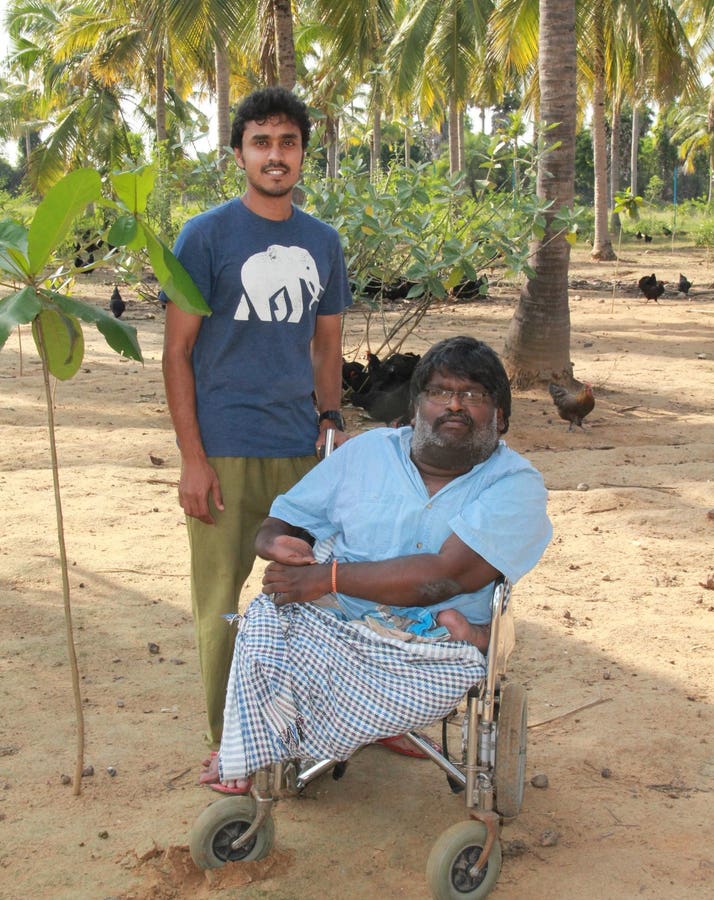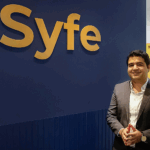Founders Manjunath Marappan and Ashok Kanna (seated).
Not long ago, Manjunath Malapan said, all chickens in India were free-range. The birds were like his grandmother’s chickens, pecking at worms and grain in the backyard.
Since the 1980s, India’s demand for eggs and chicken has soared. (Eggs are generally considered meat in India and therefore not suitable for vegetarians.) There was a shift in egg production from a largely small-scale outdoor operation to a more centralized, industrialized system. The chickens lost their freedom and were squeezed into a small space with limited space for movement.
Malapan believes that Indian consumers and farmers have also lost something in the process. He believes that returning to the roots of egg production means better jobs, more decentralized opportunities, healthier food and happier animals.
Eventually, he and his business partner Ashok Kanna decided to put their farming experience into a new venture. After several years of research, Happy Hen Farm was born in 2015. Their chickens have been free-range from the beginning. The birds are happier in other ways, too. For example, their wings and beaks are intact. In 2024, the company received the Good Egg Award from Compassion in World Agriculture, a first for India.
There are now 12 farms in the Happy Hens network spread across several states in southern India. “We’ve always been a company that grew organically,” Marapan said, finding farmers through word of mouth. Malapan reports that these include many young people and women who can maintain small egg businesses while pursuing other activities. Farmers are a combination of experienced farmers and new farmers, which means there is a two-way knowledge transaction between the company and farmers.
In addition to providing training and marketing support, the company also supplies nutritious feed and most of its indigenous chicken breeds to farmers. Breeds that are strong, agile and not necessarily fast-growing are particularly suited to outdoor living, he said.
Of course, there are some concerns about raising free-range chickens. One is that there is plenty of land, although Malapan believes that in India “we have enough space to farm”. Of course, this type of egg production is not as intensive as an industrial-scale chicken coop. Marappan said free-range producers could raise up to 3,000 chickens, while free-range (indoor) farms could raise about 20,000 chickens. The numbers are even higher for caged birds.
Another problem is predation. Malapan is also quite relaxed, saying the main predator is not meerkats or snakes, but humans. He estimates that about 1% of eggs are stolen.
Another health risk is that the suppliers of Happy Hen Farms do not create a controlled environment. Therefore, chronic respiratory diseases caused by monsoons or temperature fluctuations occasionally occur. Malapan said the company encourages taking certain precautions to reduce risk.
Faced with these potential difficulties, why would chicken farmers decide to keep free-range eggs? For one thing, starting a few backyard birds is less intimidating than the high capital costs of setting up a large enterprise. Marapan said that with the cage model, large volumes are needed to ensure profits. Instead, he said, a woman with 300 outdoor birds could earn about 10,000 rupees ($117) a month — a good amount of money in India, especially if supplemented. Consumers pay more for high-welfare eggs: cage-free eggs in India cost 50% more than cage-caught eggs.
Malapan emphasized that what is particularly important about this revenue is its stability. He said that 100% of the eggs produced are sold and the company guarantees this. Happy Hen Farm is able to do this because they sign up for the Cage Free Credit Program.
Here’s how it works: If their customers are in a place where they can’t get free-range eggs, such as a hotel in a remote area, they can arrange a digital exchange. Happy Hen Farm will sell free-range eggs locally, but conventional eggs will cost less. In the end, the hotel will buy local (caged) eggs but pay Happy Hen Farm the difference between caged and free-range eggs. Egg producers are confident that they will be able to sell all their eggs. Egg buyers get a marketing boost by saying they participate in a cage-free credit program.
What are cage-free points?
Cage-free points are still in their infancy. Singapore-based consultancy Global Food Partners launched the only program of its kind in 2020.
“This is essentially the first cage-free credit system, allowing food and hospitality businesses to offset the use of conventional or cage-free eggs through purchasing incentives and directly supporting local farmers who are pursuing higher welfare certified non-cage eggs in their countries. Cage production,” explains Elissa Lane, CEO of Global Food Partners.
In some ways, this is an extension of her previous work with farm animals at Humane Society International. Egg producers are seeking support not only with the specific logistics of cage removal, but also with related areas such as biosecurity, animal welfare and health. On the other hand, since most global food companies have cage-free egg commitments, eggs are the area where they need the most support. Companies often cite the Asian egg market as particularly challenging.
There are several reasons why free-range credit is taking off in Asia rather than the United States, Europe or Latin America. “Food companies have more influence in these areas than producers,” Lane said, and there’s also a greater demand for free-range eggs in those areas. Another problem is the vast territory, with many scattered and remote locations across Asia for egg producers and buyers. Lane commented that across Asia, “the cage-free movement is definitely growing. It’s not a mature market yet.” However, she sees progress in countries such as China, Thailand and Indonesia. Overall, there is a particular need for liquid and powdered eggs from cage-free chickens.
Lane reports that some companies buy their free-range eggs entirely on credit. But in most cases, the ratio is between 20% and 50%. The supplier sets the price for the credit, which is equivalent to 1,000 shell eggs.
So far, ten companies have publicly announced the use of such credits. These are mainly multinational companies based in Europe or the United States, such as Unilever and Krispy Kreme, which have made global cage-free commitments.
In Unilever’s 2024 Farm Animal Welfare Report, the company said it had achieved its target of 100% free-range eggs (including shell and processed eggs) in Europe and North America as early as 2020. From a global perspective, the report states, “To meet our target of transitioning to free-range eggs by the end of 2025, we are currently prioritizing physical supply. In areas where we experience availability challenges, we plan to use egg credits as an alternative The regions with the least progress are the Middle East/Turkey and Asia/Oceania; in these two regions, cage-free eggs will account for only 27% of total purchases in 2024.
As cage-free target deadlines approach (many in 2025), more companies may turn to cage-free credit. Lane said there are enough farmers willing to expand to meet all anticipated demand. “The message is that this is still completely feasible in Asia.”
The signboard of Tokyo Cafe Coborebi, one of the few companies in Japan that promotes cage-free eggs … [+]
Limitations and future of free-range credits
However, Lane warns, “without good management, free-range production can be a disaster.” Simply removing cages is not enough. From nest boxes to lighting, Global Food Partners works with suppliers like Happy Hens Farm to ensure hens are healthy and productive.
Lane hopes that while the program now provides a tool for businesses that want to go cage-free, in the future this will lead to economies of scale. Ideally, businesses will move to physical cage-free eggs within three to five years of signing up; Global Food Partners and its clients have developed a roadmap for this transition.
Lane admits that these concepts of digital credit may seem a bit abstract. But “we’re seeing the impact on animal welfare and farmers raising freedom.” In Vietnam, for example, farmers may have to keep more birds in cages without a cage-free credit program to connect them with willing buyers. inside.
The carbon offsetting scheme has been justly criticized because it does not actually increase carbon storage but uses greenwashing as an example to justify high-emitting activities. It would not be progress if a credit program also enabled the humane cleaning of animal products. But proponents of the free-range credit argue that this type of exchange is different because it directly stimulates free-range production. Some animal welfare groups, such as the Humane League, have embraced the concept.
Lewis Bollard, head of farm animal welfare work at Open Philanthropy, supports cage-free credits as an interim step. He believes this is a short-term solution for countries with little free-range production (although he stresses that 100% free-range production is possible in the United States and Europe).
World Farming Compassion is cautious. A spokesman said: “The introduction of free-range credit is a fairly new concept and it remains to be seen whether the credit will accelerate the actual transition to free-range production, particularly in areas where free-range production is difficult to access. We ask businesses to report their work transparently Cage-free progress. They must specify the proportion of physical cage-free eggs they produce/supply and the proportion covered by the points, as well as the year-to-year progress of physical cage-free eggs and away from points. Currently, we do not consider a company to be using points. The company is 100% cage-free.”
In fact, accurate labeling is critical. Lane stressed that companies using free-range credit must not claim that their supply chains are fully free-range. Instead, they can say that they support the production of free-range eggs, or that their free-range commitments have been met. The difference may be subtle to many people who just want to know that the eggs they are currently eating did not come from a closed chicken.
It’s also important to ensure that companies paying out free-range credits don’t use it as a convenient way to fall behind in cleaning up their supply chains. Lane said the points represent a hybrid approach. Her consultancy encourages businesses to purchase physical free-range eggs wherever possible; the points are just one component of their support package. In their experience, companies do want to use physical free-range eggs wherever possible because it allows them to make a stronger claim on animal welfare. In the future, Global Food Partners is willing to expand the model to other types of animals, including broiler chickens and fish.
Back in southern India, Happy Hen Farm’s Malappan admits that this is not a long-term solution in itself, but calls it a solution to build capacity to achieve a long-term vision. In the short time that cage-free credits have existed, they appear to have stimulated the production of some high-welfare eggs.
This article is part of a series on the cage-free transition of livestock industries around the world. this first article Explore the delay in implementing the European Citizens’ Initiative to ban caging.





